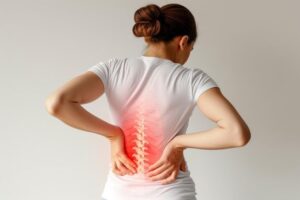Say Goodbye to Back Pain: 4 Simple Tips for Fast Relief

Millions of individuals worldwide suffer from back pain, making it one of the most prevalent health issues. Your quality of life can be significantly impacted by back pain, whether it is a subtle, persistent ache or a sharp, abrupt agony. To help you manage and even prevent this excruciating condition, we’ll look at practical back pain prevention and alleviation techniques in this article.
1. Understanding Back Pain
There are several causes of back discomfort. Poor posture, strained muscles, or even underlying medical issues like arthritis or a herniated disc can cause it. Actually, there are two main categories of back pain:
Acute back pain: Usually brought on by lifting something heavy or making abrupt movements, this type of pain can be quick, intense, and last anywhere from a few days to weeks.
Chronic back pain: defined as pain that persists for longer than three months and may be brought on by a chronic illness or injury.
Your likelihood of developing back pain is increased by a number of risk factors, such as advanced age, obesity, inactivity, and bad posture. However, back discomfort may frequently be efficiently controlled with the correct techniques.
2. Effective Techniques for Back Pain Relief
Depending on its source and intensity, back pain can be relieved in a variety of ways. Here are a few strategies to think about:
Sleeping Positioning and Resting
It’s crucial to give your muscles a break if you have back pain. Try to maintain a moderate level of activity and move about lightly, though, as extended bed rest might cause stiffness. To relieve strain on your spine and enhance your quality of sleep, place a pillow beneath your knees if you sleep on your back or between your knees if you sleep on your side.
Medicines and Treatments Sold Over-the-Counter
Acetaminophen and ibuprofen are examples of over-the-counter pain medications that can help reduce inflammation and lessen discomfort. Temporary muscle soreness can also be relieved by topical ointments or patches containing menthol or capsaicin.
Exercise and Physical Therapy
You can learn the proper exercises to strengthen your back muscles and enhance your posture with physical therapy. Additionally, these exercises aid in improving mobility and flexibility, which over time may lessen pain. A customized workout regimen tailored to your condition may be created by a physical therapist.
Therapy with Heat and Cold
Pain can be lessened and stiff muscles relaxed by using a heating pad or a warm bath. Additionally, cold compresses might help lower inflammation, particularly after an acute injury.
Alternative Medical Interventions
Alternative therapies like massage therapy, chiropractic adjustments, and acupuncture can provide relief for certain individuals. These therapies provide a non-invasive approach to pain management, albeit they might not be effective for everyone.
3. Back Pain Prevention: Strategies for Prolonged Pain Management.
Just as crucial as treating back pain is preventing it. Your risk of chronic pain can be considerably decreased by forming healthy behaviors.
The Right Posture
Maintaining your spine’s natural curve requires proper posture. Make sure your feet are flat on the floor and your back is supported when you sit. Balance your weight equally on both feet when standing. Do not slouch; instead, keep your shoulders back.
Exercises to Strengthen Your Spine
Your spine will be supported and strain will be avoided if you strengthen your core muscles, which include your back, pelvic, and abdominal muscles. Strengthening exercises like planks, leg lifts, and back extensions are excellent.
Ergonomics in Everyday Tasks
Setting up an ergonomic workspace is essential if you spend a lot of time at a desk. Make sure your screen is at eye level and your knees and hips are at the same height in your chair. Avoid twisting your body and always bend your knees rather than your back while lifting heavy goods.
Stretching to Increase Flexibility
Stretching on a daily basis keeps your muscles and spine flexible. Simple stretches that increase flexibility and decrease muscular tightness include cat-cow stretches, torso twists, and touching your toes.
Controlling Weight
Your back is strained harder when you carry excess weight, particularly around your midsection. You can lower your risk of developing back pain and enhance the general health of your spine by maintaining a healthy weight with a balanced diet and consistent exercise.
4. When to Get Expert Assistance
The majority of back pain may be treated at home, but occasionally medical assistance is required. Seek expert assistance if:
1.The soreness doesn’t go away after a few weeks.
2.You have excruciating limb pain, tingling, or numbness.
3.You have trouble bending, walking, and standing.
4.You get back discomfort and bladder or bowel problems.
A medical expert, such as a chiropractor or orthopedic physician, can offer a comprehensive assessment and suggest suitable therapies. In certain situations, treating severe back pain may need surgery or injections.
Conclusion
Although back pain is a common problem, it can be efficiently controlled and even avoided with the correct techniques. There are numerous things to think about, ranging from basic lifestyle adjustments like better posture and consistent exercise to more sophisticated therapies like physical therapy or alternative therapies.
To overcome back pain, keep in mind that proactive treatment and early intervention are essential. For individualized guidance, speak with a healthcare provider if you’re experiencing ongoing discomfort. For long-term comfort and prevention, take action now and don’t let back pain rule your life.

